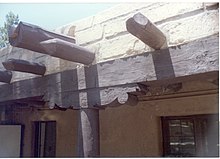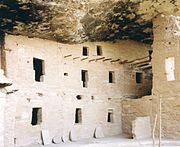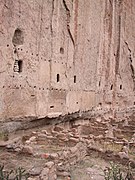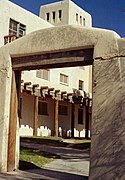Viga (architecture)




Vigasarewoodenbeamsused in the traditionaladobearchitecture of theAmerican Southwest,especially inNew Mexico.In this type of construction, the vigas are the mainstructural memberscarrying the weight of the roof to the load-bearing exterior walls. The exposed beam-ends projecting from the outside of the wall are a defining characteristic ofPueblo architectureand ofSpanish Colonial architecturein New Mexico, often replicated in modernPueblo Revival architecture.Usually the vigas are simply peeled logs with a minimum of woodworking. In traditional buildings, the vigas supportlatillas[1] (laths) which are placed crosswise and upon which the adobe roof is laid, often with intermediate layers of brush or soil.[2]Thelatillasmay be hewn boards, or - in more rustic buildings - simply peeled branches.[3]These building techniques date back to theAncestral Puebloanpeoples of 750 to 1300 CE, and vigas (or holes left where the vigas have deteriorated) are visible in many of their surviving buildings.
Since the popularization of the modern Pueblo Revival style in the 1920s and 1930s, vigas are typically used for ornamental rather than structural purposes. NotedSanta FearchitectJohn Gaw Meem(1894-1983) incorporated ornamental vigas into many of his designs. Contemporary construction inSanta Fe, New Mexico,which is controlled by stringentbuilding-codes,typically incorporates ornamental vigas, although the 2012 revision of the residential building-code gives credit for structural vigas.[4]Older structures that have been reconstructed (e.g. thePalace of the Governorsin Santa Fe) may contain both structural and ornamental vigas.
Etymology
[edit]The wordvigaisSpanishfor "beam", "rafter" or "girder".[5]
Composition
[edit]Vigasare typically about 6 to 10 inches (15.24 to 25.4 cm) in diameter and average 15 feet (4.6 m) long.[6]Pinyon(Pinus edulis) andPonderosa Pinewere the most common wood species used forvigasduring the 17th century.Engelmann spruceis preferred because of "wood character and lack of cracking," butPonderosa pine(Pinus ponderosa) is more commonly used.[7]Because the availability ofvigaslonger than15 feet is limited by the size of the trees cut for the purpose, traditionalviga-constructed rooms are typically less than 15 feet (4.6 m) wide.[8]A layer of smaller branches or saplings known aslatillasorlatias(laths) is laid over the top of the vigas, and then a slightly sloped layer of adobe is added on top of thelatillasfor insulation and drainage.
Althoughvigaswere sometimes salvaged from old buildings to erect new ones, such as inWalpi,this practice depended on the condition of the site and the material salvaged. The use of traditional roundedvigaschanged with the arrival of the railroad in the 1880s, which broughtdimensioned lumber,andimmigrantswho used different construction methods, from the east coast.[9]
Materials
[edit]Cutting trees for vigas was usually done in winter because of the good temperatures. “Dead and down” trees were the preferred source for vigas in the adjacent forests. Traditional vigas were usually cut to length with metal axes.Latillaswere also collected, along with other construction materials at the same time. To make transportation easier, wood preparation usually was done before shipment. Large labor crews were involved, and vigas were transported from the mountains by teams ofoxen.[10]Some construction historians have mentioned the use oflatillasunder the vigas for carrying poles.[11]
Wood cutting was an important aspect of material production. If cutting was done shorter than needed, the builders had to wait until one year later to get the same material, thus representing a problem. These issues led to some structural and designing decisions in constructions, such as the building of second walls inside the proposed building so shorter materials could be used.
Large diameter vigas were cut first so that they can dry or cure for a longer period.[11]As lighter elements for transportation,latillasorlatiaswere cut last from various wood types. These were then sorted and laid out in different patterns from the vigas and painted in a different colors.[12]The 1846 American immigration brought notions ofNew Englandarchitecture. New technologies substituted the use of vigas for machine-sawn beams, among other construction techniques that followed to the 20th century. This practice did not interfere with the use of vigas for mostly decorative purposes in the Pueblo Revival Style architecture between the 1920s and 1930s.
Structural assembly
[edit]Traditional vigas were mostly used forstructuralpurposes in buildings. Vigas were often spaced 3 feet (0.91 m) apart, although irregular or unequal spaced was characteristic of Spanish colonial architecture. Buildings using viga roof construction vary from large institutional buildings to small ones. The amount of vigas used for a room vary, but six was the standard. Some rooms inAcomaare roofed with five to nine vigas.[9]Also, other structural practices were added to later buildings, such as placing horizontal bond beams to transfer structural loads to the adobe roof.
The extension of vigas some feet outside of the wall is a standard practice. This was used for the creation ofportalesor covered porches. Anumbralorlintelwas added for support of the viga along with verticalpostsin these spaces.[12]The porch's roof treatment was the same as in the interior room, but the space provided was used for different purposes.
Vigas were usually installed with the smaller ends to one side of the roof to facilitate gooddrainage.[12]Vigas usually sat directly on the adobe orstone wallsand were strapped. Decorativecorbelswere used in theportalesand in the interiors.
New technologies, especially in Pueblo Revival Architecture, were integrated. The practice of anchoring Vigas with rebar through pre-drilled holes at opposing angles and the designing ofparapetsfor anchoring, was ideal for vigas in low flat roofs. This was used to prevent roof uplift.[13]
Thevaultedviga roof is another type of structural system using vigas, using parapets on the two side and eaves on the ends. The roof is left exposed on the interior andlatillasare placed parallel with others in a diagonal pattern.[14]
Examples
[edit]-
Pueblo Bonito,constructed by Ancestral Puebloan people between 850 and 1150 CE
-
Spruce Tree House,Mesa Verde National Park
-
Viga holes in cliff dwellings atBandelier National Monument
-
Mesa Vista Hall (1950),University of New Mexico,a modern building with vigas used as ornamentation
-
TheArt Annex(1926) at UNM, a more abstract Pueblo style building, evokes vigas using stylized ornamentation
Featured buildings
[edit]- Acoma Pueblo
- San Esteban del Rey Mission
- Pueblo del ArroyoPalace of the Governors
- Taos Pueblo
- Mission Nuestra Señora de los Ángeles de Porciúncula de los Pecos
- Pueblo Bonito
- La Fonda on the Plaza
- Taylor Memorial Chapel
- Cristo Rey Church
- New Mexico Museum of Art
- Painted Desert Inn
- Cabot's Pueblo Museum
- Hodgin Hall
- Estufa
- Chaco Culture National Historical Park
- Salinas Pueblo Missions National Monument
- Santa Clara Pueblo, New Mexico
- Mission Nuestra Señora de la Asunción de Zia
- Kewa Pueblo, New Mexico
See also
[edit]Notes
[edit]- ^ Latilla definition and meaning
- ^Mountain Zamora, Luis (2015). "Taos Pueblo Preservation Program".APT Bulletin.46(4): 40.JSTOR43659962.
- ^Groben, W. Ellis (1941).Adobe Architecture: Its Design and Construction(PDF).U.S. Forest Service.RetrievedMarch 29,2018.
- ^City of Santa Fe (2012-01-11)."Draft Revisions to the Santa Fe Residential Green Building Code".Retrieved2012-07-02.
- ^ "viga".Oxford English Dictionary(Online ed.).Oxford University Press.(Subscription orparticipating institution membershiprequired.)
- ^DICKEY, ROLAND F. (Winter 1948). "EARTH IS LIFTED: Domestic Architecture in New Mexico".Southwest Review.33(1): 32.JSTOR43463318.
- ^Windes, Thomas C. (March 2010). "Dendrochronology and Structural Wood Use at Pueblo Del Arroyo, Chaco Canyon, New Mexico".Journal of Field Archaeology.35(1): 88.JSTOR24406839.
- ^Gleye, Paul (Autumn 1994). "SANTA FE WITHOUT ADOBE: LESSONS FOR THE IDENTITY OF PLACE".Journal of Architectural and Planning Research.11(3): 182.JSTOR43029123.
- ^abRobinson, William J. (1990). "Tree-Ring Studies of the Pueblo de Acoma".Historical Archaeology.24(3): 101.JSTOR25615797.
- ^Gale (1996).Encyclopedia of the American West.U.S. History In Context.
- ^abWindes, Thomas C. (March 2010). "Dendrochronology and Structural Wood Use at Pueblo del Arroyo, Chaco Canyon, New Mexico".Journal of Field Archaeology.35(1): 91.JSTOR24406839.
- ^abcRiley Bartholomew, Philip (1983).THE HACIENDA: ITS EVOLVEMENT AND ARCHITECTURE IN COLONIAL NEW MEXICO 1598-1821.Missouri: University of Missouri - Columbia. p. 292.
- ^Kaki, Hunter (2004).Earthbag building: the tools, tricks and techniques.New Society Publishers, NSP. p. 115.ISBN978-0865715073.OCLC475066177.
- ^Kaki, Hunter (2004).Earthbag building: the tools, tricks and techniques.New Society Publishers, NSP. p. 117.ISBN978-0865715073.OCLC475066177.
References
[edit]- Bunting, Bainbridge (1983).John Gaw Meem: Southwestern Architect.Albuquerque: University of New Mexico Press.ISBN0-8263-0251-3
- Cameron, Catherine M.Architectural change at a Southwestern Pueblo.PhD. Diss., University of Arizona, 1991.
- Dickey, Roland F., and Faris, Tom. "Earth Is Lifted: Domestic Architecture in New Mexico."Southwest Review33, no. 1 (Winter 1948): 31-37.
- Frederick Gritzner, Charles.Spanish Log Construction in New Mexico.PhD. Diss., Louisiana State University, 1969, 63.
- Gleye, Paul. "Santa Fe without Adobe: Lessons for the Identity of Place."Journal of Architectural and Planning Research11, no. 3 (Autumn 1994): 181-96.
- Harris, Cyril M.Dictionary of Architecture & Construction.4th ed, 1045-1046. New York: McGraw-Hill, 2006.
- Hunter, Kaki, and Donald Kiffmeyer. "Roof Systems." InEarthbag Building: The Tools, Tricks and Techniques,115-18. Gabriola Island: New Society, 2004.
- Knox Wetherington, Ronald.Early Occupations in the Taos District in the Context of Northern Rio Grande Culture History.PhD. Diss., University of Michigan, 1964.
- McAlester, Virginia, Suzanne Patton. Matty, and Steve Clicque.A Field Guide to American Houses: The Definitive Guide to Identifying and Understanding Americas Domestic Architecture,542-545. New York: Alfred A. Knopf, 2017.
- Mountain Zamora, Luis; Kay Judy, Mary (2015). "Taos Pueblo Preservation Program".APT Bulletin.46(4): 38–45.
- Phillips, Charles, and Alan Axelrod, eds. "Architecture: Adobe Architecture." InEncyclopedia of the American West.USA, 1996.
- Riley Bartholomew, Philip.The Hacienda: Its Evolvement and Architecture in Colonial New Mexico 1598-1821.PhD. Diss., University of Missouri-Columbia, 1983.
- Robinson, William J (1990). "Tree-Ring Studies of the Pueblo De Acoma".Historical Archaeology.24(3): 99–106.doi:10.1007/bf03374140.
- Whalen, Michael A.; MacWilliams, A.C.; Pitezel, Todd. "Reconsidering The Size and Structure of Casas Grandes, Chihuahua, Mexico".American Antiquity.75(3): 527–50.doi:10.7183/0002-7316.75.3.527.
- Windes, Thomas C. "Dendrochronology and Structural Wood Use at Pueblo Del Arroyo, Chaco Canyon, New Mexico".Journal of Field Archaeology.35(1): 78–98.doi:10.1179/009346910x12707320296757.





